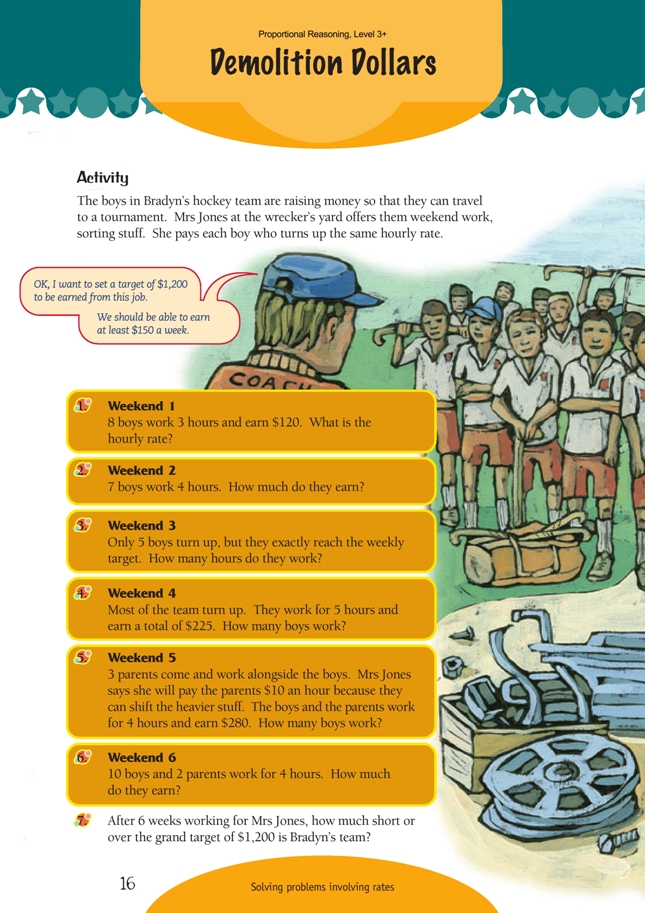This is a level 4 number activity from the Figure It Out series. It relates to Stage 7 of the Number Framework.
A PDF of the student activity is included.
Click on the image to enlarge it. Click again to close. Download PDF (1075 KB)
calculate rates to solve problems
Number Framework Links
Use this activity to help students:
• consolidate their knowledge of basic facts (stage 6) and advanced multiplicative strategies (stage 7)
• develop strategies for solving problems involving rates and proportion (stage 7).
This activity requires students to work through a series of problems, each of which has one missing detail that can be deduced using proportional reasoning. The speech bubble and the answer to question 1 contain information that is needed for answering questions 2–7; questions 2–6 are not interdependent, but question 7 relies on correct answers for questions 2 and 6.
The activity is rich with potential for proportional reasoning. Each part can be solved in a variety of different ways, and the numbers are such that there is no need for a calculator. Those who like the challenge of a puzzle may be able to work through each step independently, but you may prefer to discuss it first with your students before setting them to work in pairs or small groups. Make sure that you give them the opportunity to share their strategies.
The following paragraphs suggest one way of reasoning out the answer to each question:
For question 1, we know that the boys worked 24 hours in total and earned $120. Using a halving strategy, 120 ÷ 24 = 60 ÷ 12 = 5, so the pay rate is $5 per hour.
The calculation for question 2 is 7 x 4 x 5 = $ . 28 x 5 = 14 x 10 = $140 (doubling and halving). Alternatively, students may realise that 1 boy working for 4 hours earns $20, so 7 boys working for 4 hours will earn 7 x 20 = $140.
The weekly target mentioned in question 3 is $150. This represents 30 hours’ work. If 5 boys worked for a total of 30 hours, they each worked for 6 hours (6 x 5 = 30).
In week 4 (question 4), the boys earned $225 in 5 hours, so in 1 hour they must have earned 225 ÷ 5 = $45. If the boys earned $45 in 1 hour, there must have been 9 boys working (5 x 9 = 45).
In question 5, we know how many parents worked, so one approach is to begin by finding out what the parent contribution was. The 3 parents worked for 4 hours at a rate of $10 per hour, so they earned 3 x 4 x 10 = $120 of the total of $280. This means the boys earned 280 – 120 = $160.
The boys also worked for 4 hours, so each hour they earned 160 ÷ 4 = $40. This means that 8 boys worked that day (5 x 8 = $40).
In question 6, we have all the details we need to go straight to the answer: the boys earn $(10 x 4 x 5) and the parents earn $(2 x 4 x 10). 10 x 20 + 8 x 10 = 200 + 80 = $280.
Question 7 requires students to add together the totals for the 6 weekends:
120 + 140 + 150 + 225 + 280 + 280 = $1,195. So Braydn’s team is short of its target by $5.
Answers to Activity
1. $5. (120 ÷ 24 = 5)
2. $140. (7 x 4 x 5 = 140)
3. 6 hours. (150 ÷ 5 = 30; 30 ÷ 5 = 6)
4. 9 boys. (255 ÷ 5 = 45; 45 ÷ 5 = 9)
5. 8 boys. (Parents earn 3 x 10 x 4 = $120; boys earn $160. Each boy earns 4 x 5 = $20. Number of boys is 160 ÷ 20 = 8)
6. $280. (Parents earn 2 x 4 x 10 = $80; boys earn 10 x 4 x 5 = $200. 80 + 200 = $280)
7. $5 short
